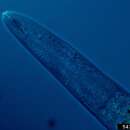fr
noms dans le fil d’Ariane


Trichodoridae (stubby-root nematodes, trichodorids) is a family of terrestrial root feeding nematodes, being one of two that constitute suborder Triplonchida.[3][4] They are economically important plant parasites and virus vectors.[5][6]
The first trichodorid was described in 1880 (De Man) as Dorylaimus primitivus, and the type genus, Trichodorus described in 1913 by Cobb, based on Trichodorus obtusus.[7]
Historically, up to 1973, Trichodorus was the only genus in this family. Originally it was the only genus in a subfamily, the Trichodorinae Thorne 1935,[1] within the family Diphtherophoridae, to distinguish it from the other subfamily, Diphtherophorinae.[8] However Diphtherophoridae was elevated to superfamily rank, and the subfamily Trichodorinae became a full-fledged family.[9] The genus Trichodorus was split into two genera in 1974 by Siddiqi,[10] Trichodorus and Paratrichodorus. This was based on the position of the gland nuclei and the type of pharyngo-intestinal junction. Siddiqi also used these criteria to divide Paratrichodirus into three subgenera, Paratrichodorus, Atlantadorus and Nanidorus. Rodriguez-Montessorosoon proposed further separating these genera into two subfamilies, resurrecting the name Trichodorinae.[11] With Siddiqi's subgenera not accepted by all authorities,[12] his elevation of these subgenera to genus level in 1980[13][14] was followed by even fewer,[15] but now is finding supports in molecular systematics.
In the case of Nanidorus, phylogenetic analysis has supported its recognition as a separate genus, although clustering with Trichodorus rather than its parent Paratrichodorus.[15][16]
There were few species recognised before the economic importance of the family was recognised, and in 1957 there were only 12, but this increased rapidly. In addition further genera than the original Trichodorus (1913) and Paratrichodorus (1974) were created in the 1970s, and another genus in 2002.[17]
There are now about 100 species divided into five to six genera.[18][19] Duarte et al. (2010) list 102 species.[15]
The two largest genera have didelphic females (two genital tracts), and are distributed worldwide. In the contrast the three small genera, have females that are monodelphic-prodelphic (single tract) and are native to Central America and the northern part of South America.
Trichodoridae comes from the Greek trichos (a hair) and dory (a spear).[4] The name "stubby-root" comes from the effect of the nematodes on the root system which appears "stubby" or stunted.[23][5]
The family only became of interest in 1951.[24] At that time Trichodorus christie (=Paratrichodorus minor) was recognised as a pest of crops (beets and corn) in Florida.[17] In 1961 it was discovered that they were also virus vectors,[25] though this seems to be mainly the didelphic genera.[15]
Trichodoridae (stubby-root nematodes, trichodorids) is a family of terrestrial root feeding nematodes, being one of two that constitute suborder Triplonchida. They are economically important plant parasites and virus vectors.
Trichodoridae hay tên khác là stubby-root nematodes, trichodorids, là tên của một họ của các loài giun đất ăn rễ cây. Nó là 1 trong 2 họ của phân bộ Diphtherophorina, thuộc bộ Triplonchida[3][4]. Về phương diện kinh tế thì chúng là loài kí sinh chủ yếu của cây trồng và vật chủ trung gian của các loài vi-rút.[5][6]
Họ này được biết đến vào năm 1951[7], khi đó, Trichodorus christie (tên đồng nghĩa của Paratrichodorus minor) được người ta nhận ra là 1 mối đe dọa cho vụ mùa (cây củ cải đường và bắp) tại Florida[8]. Ngoài ra, vào năm 1961, người ta phát hiện ra chúng cũng là vật chủ trung gian của vi-rút[9].
Năm 1880, một loài thuộc họ này tên là Dorylaimus primitivus được De Man mô tả và năm 1913, chi Trichodorus được Cobb mô tả dựa trên các đặc điểm của Trichodorus obtusus.[10]
Theo như trường hợp của Nanidorus, theo như sự phân tích phát sinh loài thì đã cho ta thấy nó là một chi riêng biệt. Mặc dù việc xếp nó với Trichodorus thì có phần hơi xa so với tổ tiên của nó là Paratrichodorus.[11][12]
Trước khi tầm quan trọng về kinh tế của loài này được nhân ra thì có rất ít loài, vào năm 1957 thì chỉ có duy nhất 12 loài[8]. Nhưng sau đó thì số lượng loài lại tăng lên nhanh chóng. Đến hiện tại thì có 102 loài[11], được đưa vào 6 chi[13][14]:
Trichodoridae xuất phát từ 2 từ tiếng Hy Lạp là trichos có nghĩa là lông hoặc tóc và dory có nghĩa là cái giáo[4]. Còn tên "stubby-root" là chỉ tác động của loài giun tròn này lên hệ thống rẽ làm cho nó bị kìm hãm sự phát triển.[19][5]
Trichodoridae hay tên khác là stubby-root nematodes, trichodorids, là tên của một họ của các loài giun đất ăn rễ cây. Nó là 1 trong 2 họ của phân bộ Diphtherophorina, thuộc bộ Triplonchida. Về phương diện kinh tế thì chúng là loài kí sinh chủ yếu của cây trồng và vật chủ trung gian của các loài vi-rút.